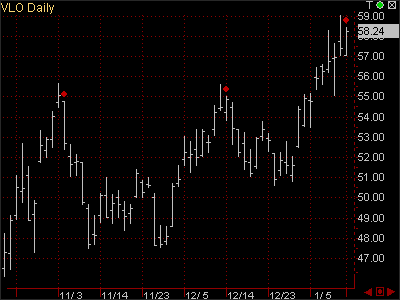Learn How to Trade the S&P Futures TopGun Software
Post on: 8 Июнь, 2015 No Comment

There are Three Main Ways for Successfully Trading the Futures
Method 1) Trend Following - Trading With the Trend, Anticipating Trend Direction and Using Retracements / Entering on Pullbacks.
Method 2) Range Trading — Many days the market has no clear trend, learn how to trade and when to buy and sell on these days.
Method 3) Trend Reversal — Using Volatility, Major Areas of Support & Resistance, and Trend Reversal Tool to Anticipate Reversals
Method 1) Trend Following — How to Know in Advance Which Way the Market is MOST Likely to Trade
Breakthrough Concept — Use the Stocks that Makeup the Futures/Sectors to PREDICT Market Direction in ADVANCE!
One of the most useful tools in TopGun Software for Futures and Stock Traders is the Balance Point Sectors group of tools. We have this tool for all the major Indexes (S&P, NASDAQ, Dow, and Russell) as well as the major Sectors (Semiconductors, Technology, Biotechnology, Drugs, Banks, Retail, Oil, Housing).
Here’s how it works:
Every stock has a higher probability (of various degree) of going up or down. Without revealing our secret formula, and it is very complex due to analyzing every trade in every stock throughout the day, we show you if each sector and index is more likely to go up or down. We calculate each indexes and sectors balance level and our tool shows how far they are above or below balance.
Easy to interpret, these set of tools will let you know when to buy, when to sell, and just as importantly when the market is likely to be choppy and directionless. Knowing when not to trade or to trade more cautiously gives you an incredible edge over other traders who trade the same way day in and day out. And as you will see, these tools are one of the few leading indicators in existence and frequently predict futures movements 3 to 15 minutes before they occur!
Here’s How to Immediately Profit from Knowing ahead of time which way the market will go.
Rule 1) Look to BUY when 3 out of the 5 sectors are Above their Balance Points .
Rule 2) Look to SELL when 3 out of the 5 sectors are Below their Balance Points .
Rule 3) If 4 or 5 out of 5 sectors are Above their Balance Points a nice up trend should develop.
Rule 4) If 4 or 5 out of 5 sectors are Below their Balance Points a nice down trend should develop.
Rule 5) On gap days this tool is absolutely essential for knowing whether to Fade the gap or Trade in the Gap’s Direction.
Example 1: We recommend that you watch the Semiconductors, Technology, Drugs, Banks, and Retail Sectors using this tool. Together they makeup over half of the S&P list of companies. The Semiconductors and Technology sectors often lead the market and on days where the market has gapped, or is choppy we recommend using these two sectors to decide which way to trade.
In the example below you can see our Balance Point Semi, Tech, Drugs, Banks, and Retail tools. All Sectors have gone Below Balance immediately into the day and about 15 minutes BEFORE the market has a tremendous sell off. Also note that they remain below balance all day long, keeping you short and catching you an amazing 20 S&P points ($1,000 Profit per contract traded).
Seeing real time buying and selling in the stocks that makeup the futures is another leading indicator we give you that forecasts 80%+ of the time which way the market will move.
Buy / Sell Pressure S&P This unbelievable tool shows how much BUYING and SELLING is going on in all the stocks that makeup the S&Ps. We have this tool for all the sectors and other indexes as well. Over the two days shown in this example it is CRYSTAL clear that when heavy buying comes in the market LATER goes up. When there is heavy selling the market falls. Simple. The way trading should be.
Example 2: In the below example you can see the market gapped up and the Banks, Drug, and Retail sectors are showing some initial weakness while the Semiconductors and Tech sectors had mild strength. Twenty minutes into the day the Semiconductors and Tech went negative and ALL 5 sectors were weak predicting that the market will fall. Within minutes the market begins to drift lower. Some traders scalp and some try to pick up multiple point moves but it is clear either way that shorting was the easiest way to trade. You can short when you see these signals or if you scalp then sell every rally as long as our Balance Point Sector tool confirms it.
Banks and Retail show as the weakest sectors. If a sector has showed strength early in the day you will often see strength in that sector later as well. During the market’s drift down you will notice that the Semiconductors went positive again and the Technology sector was right around its balance point level. These two sectors often lead the market and if they are not weak it is unlikely that the market will make a big move down. This tool showed you that while the edge was in shorting, you shouldn’t expect to find a big downtrend and to take small profits.
At 11:30 am EST the Drug sector went positive for the first time of the day, 15 minutes later the Semiconductors went positive and 10 minutes later Technology followed. At this point we have 4 out of the 5 sectors above their balance point and a large uptrend developed. Remember we buy when 3 out of the 5 sectors are Green and short when 3 out of the 5 are Red. Whenever you see 4 or more sectors Green you can expect to find a big up move. In this example these tools predicted a nice 9 point S&P move. That’s $450 per S&P contract traded.
As the market made a higher high after 1:30 pm EST note that the Semiconductor, Tech, and Bank Sectors were getting weaker. At 2pm EST the Bank sector went negative again and 20 minutes later the Tech sector followed. Additionally, the Semiconductors were getting close to turning negative. This gave you an EARLY Warning that the market was likely to reverse. At this point you should look to enter short.
Other Indicators: The yellow line is the balance point tool for the S&P futures. It is where the average trader has a position and is an amazing support/resistance tool. The red and green signals show when the Trend is likely to reverse. When you see these the market usually either consolidates sideways or reverses.

Example 3: In the below example the market gaps down. On the first bar of the day you can see that the Semis and Retail are below balance but Tech, Banks and Drugs are positive. This is the first sign that the market is more likely to go UP than down. On the second bar of the day the Banks just dip under their balance point while the Retail sector went positive. There is still 3 out of 5 sectors above balance and the edge is still in going long. The market breaks up on the next bar, our tool having predicted this move 10 minutes before it occurred. Semiconductors confirm the breakout and jump positive. You can now see 4 out of 5 sectors are above balance and a nice 6+ S&P trend develops. This is a $300 profit per contract traded in only about 40 minutes.
Usually after the market makes a move it will return to the yellow balance point line and find support. That is exactly what has happened here. Usually the first time the market does this you can buy and it will return higher. Because the market gaped down with initial weakness a trader should be cautious and be aware that the odds of another big up move are lower than if the market started off neutral or strong. This is all common sense but I want to point this out to beginning traders as it can take months or years to learn how markets ‘normally’ trade.
When most traders expect the market to go up and it doesn’t, it will almost always go the opposite way as traders who are wrong all exit at the same time. That’s exactly what happened. Notice the Banks, Retail and Semiconductors turn negative, a low risk short would be on the rally back up to the yellow balance point line at 1284.00 at 11:20am EST. Four out of the 5 sectors are now negative predicting a big down trend which is exactly what happened.
Note as the market was going down, the Semiconductors flipped positive and negative a few times and was hovering near its balanced state. When the Semiconductor and Tech sectors are not too weak the market is unlikely to continue to trend lower. In this case it bounced right near the Pivot Level S2. We teach these techniques in our training class which is free to those who purchase rather than lease our software. At the lows the Semiconductors became positive and the Drug sector was less weak than it was earlier. This is showing you that two major sectors are not getting weaker as you would expect if the market was to continue down. Aggressive traders could look to buy this support area with a profit target at the balance point line (yellow) or the next Pivot area (red line). Less aggressive traders should be aware that the downtrend is likely to end and either tighten their stops or exit with nice profits here.
As the market did go back up most of the sectors reversed and went positive but barely so. The pivots make amazing support and resistance tools and many traders use them to pinpoint low risk buy and sell zones. We show a Trend Reversal sell signal just 1 bar before the S&P’s hit the Pivot S1 level. All sectors except Semis go negative here which is a clear sign that the market is likely to go back down which it does.
Many experienced traders use swing levels to predict future moves. This is accomplished by looking to see if the market makes higher highs or lower lows. The market made a big move up in the afternoon and then sold off but didn’t come close to the days low. This was a sign that the market was likely to go back up again and 4 out of 5 sectors turned positive right giving you confidence that the market is likely to continue higher.
Note: This indicator actually predicts price movement on most days. On some days, as in this example, the sectors change direction as the market is making its move. On these days this tool can give you confidence to hold your positions longer and lets you see if sectors are getting stronger or weaker than earlier in the day. Notice that the day ends with all sectors above their balance point level and the market gaps up the next day. This is no coincidence and it is another way you can use this tool to predict what is most likely to happen.
Other TopGun Tools to Predict Market Direction
Real Time S&P, NASDAQ, Dow, and Russell Tick
Many traders use the New York Stock Exchange Tick
Balance Point Line (Yellow Line) — Shows Average Traders Position Location














